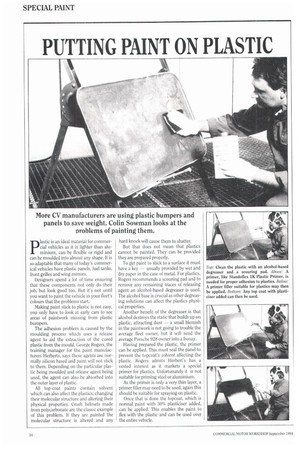PUTTING PAINT ON PLASTIC
Page 108

If you've noticed an error in this article please click here to report it so we can fix it.
More CV manufacturers are using plastic bumpers and panels to save weight. Colin Sowman looks at the problems of painting them.
plastic is an ideal material for commercial vehicles as it is lighter than aluminium, can be flexible or rigid and can be moulded into almost any shape. It is so adaptable that many of today's commerical vehicles have plastic panels, fuel tanks, front grilles and wing mirrors.
Designers spend a lot of time ensuring that these components not only do their job, but look good too. But it's not until you want to paint the vehicle in your fleet's colours that the problems start.
Making paint stick to plastic is not easy, you only have to look at early cars to see areas of paintwork missing from plastic bumpers.
The adhesion problem is caused by the moulding process which uses a release agent to aid the extraction of the cured plastic from the mould. George Rogers, the training manager for the paint manufacturers Herberts, says these agents are normally silicon based and paint will not stick to them. Depending on the particular plastic being moulded and release agent being used, the agent can also he absorbed into the outer layer of plastic.
All top-coat paints contain solvent which can also affect the plastics, changing their molecular structure and altering their physical properties. Crash helmets made from polycarbonate are the classic example of this problem. If they are painted the molecular structure is altered and any hard knock will cause them to shatter.
But that does not mean that plastics cannot be painted. They can be provided they are prepared properly.
To get paint to stick to a surface it must have a key — usually provided by wet and dry paper in the case of metal. For plastics, Rogers recommends a scouring pad and to remove any remaining traces of releasing agent an alcohol-based degreaser is used. The alcohol base is crucial as other degreasing solutions can affect the plastics physical properties.
Another benefit of the degreaser is that alcohol destroys the static that builds up on plastic, attracting dust — a small blemish in the paintwork is not going to trouble the average fleet owner, but it will send the average Porsche 928 owner into a frenzy.
Having prepared the plastic, the primer can be applied. This must seal the panel to prevent the topcoat's solvent affecting the plastic. Rogers admits Herbert's has a vested interest as it markets a special primer for plastics. Unfortunately it is not suitable for priming steel or aluminium.
As the primer is only a very thin layer, a primer filler may need to be used, again this should be suitable for spraying on plastic.
Once that is done the topcoat, which is normal paint with 30% plasticiser added, can be applied. This enables the paint to flex with the plastic and can be used over the entire vehicle.




















































































































